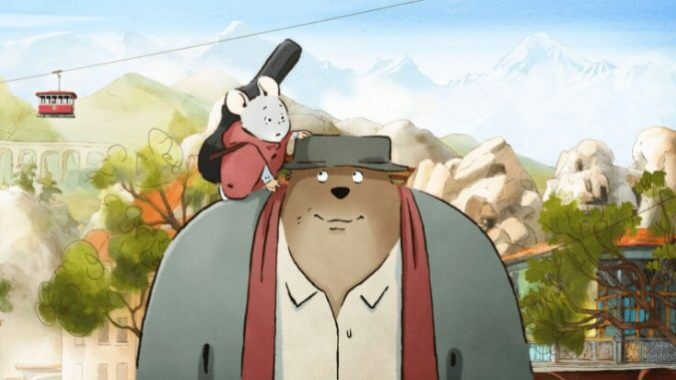StudioCanal. 2023. Animated. 80 min.
Grade: 3.5 out of 4
For those who’ve begun to tire of the Disney and Pixar formula, the one that threatens to congeal each film into a thematically worn-down tale of a plucky young girl, princess, toy, fish, or ball of fire who finds their place in the world and their own individuality, there’s a bear and a mouse who’d like a word with you. They are Ernest and Celestine and in their second French language, big screen outing, Ernest & Celestine: A Trip to Gibberitia, they embark on a watercolor adventure that looks and sounds modest enough. But within the pleasingly imperfect hand drawn lines of its characters and the charming bickering of its leads lies a delicately audacious tale of government censorship whose take on the idea of children charting a life path distinct from their parents makes Disney’s recent output look like child’s play.
Marveling at how co-writers Guillaume Mautalent, Sébastien Oursel, and Jean Régnaud were able to deliver such heavy personal and political messaging with such a delicate touch is one of the joys of this imaginative and quietly inspiring sequel to 2012’s Ernest & Celestine. That Oscar nominated French production—based on a series of children’s books by the late Belgian writer and artist Gabrielle Vincent—introduced moviegoers to its two title characters; Ernest, a cranky and penniless bear who ekes out a meager living playing the violin, and Celestine, an orphaned mouse living in an underground world that fears bears even if she doesn’t. The film was a warm and delightful tale of how unlikely friendships can be the most satisfying friendships of all.
The sequel expands upon the relationship between Ernest and Celestine (voiced, once again, by Lambert Wilson and Pauline Brunner respectively) while taking thematic leaps that are timely and timeless and conveyed with zero moralizing. Easing us into the story is a pleasure given the visuals that recall Ludwig Bemelman’s Madeline series and A.A. Milne’s Winnie the Pooh. It doesn’t hurt that Ernest and Celestine are distinct not just in size and species but in temperament. Sweet, loyal and ever-so-cute with her little red poncho and baby doll voice, Celestine has done little to fill the cabinets with food during Ernest’s winter hibernation and things get worse when she accidentally breaks Ernest’s beloved Stradibearius violin. Repairing their only source of income requires a trip to Ernest’s hometown of Gibberitia, which he is mysteriously reluctant to do.
Not many animated films conjure up the sci-fi authoritarian fantasia of Terry Gilliam’s Brazil, but this film manages to do it after Celestine takes off for Gibberitia to bring Ernest’s violin to repairman Octavious (Jean-Marc Pannetier). When Ernest catches up with her, co-directors Benjamin Renner, Vincent Patar, and Stéphane Aubier introduce Celestine—and us— to a town swimming in odd and wonderful designs like the network of gondolas that ferry citizens around Gibberitia and the traffic signals with seven lights flashing green and red. There are also touches that suggest the world that Gibberitia has become since Ernest left, like the Soviet-style statue of a hand holding a gavel. The subtle and not so subtle political overtones are cleverly baked into the story beginning with a brilliant introduction to Gibberitia that involves a musical concert in the park where the pianist only plays one note; in fact, his piano only has one key and playing any other notes is punishable with jailtime. This idea of a lack of choice extends to the familial when Ernest is reunited with his father, (Michel Lerousseau) a judge who has long harbored bitter disappointment that Ernest didn’t follow in his career footsteps. In fact, in Gibberitia all girls have no choice but to go into the same career as their mother, and the same goes for fathers and sons.
The issues that forced Ernest to leave town in the first place dovetail smoothly into the film’s larger concerns which don’t get in the way of a central friendship. It’s a lot to juggle and the movie, helped by its warm and cozy visuals, effortless packs it all into a tight 80 minutes. Ernest & Celestine: A Trip to Gibberitia may, on its 2D, childhood-evoking surface, contain many of same beats one would expect from animated fare; there are chase scenes, silly bits of humor, and a cutesiness to some of the characters, especially Celestine. But the film is a work of Gallic, pastel-colored rebellion designed as a lovely little kids film where the masked vigilante fighting for the rights of artistic expression is wanted for “musical resistance.” It’s a movie where the colors aren’t bold but the ideas certainly are. And to quote the motto of Gibberitia, “that’s just how it is.”

